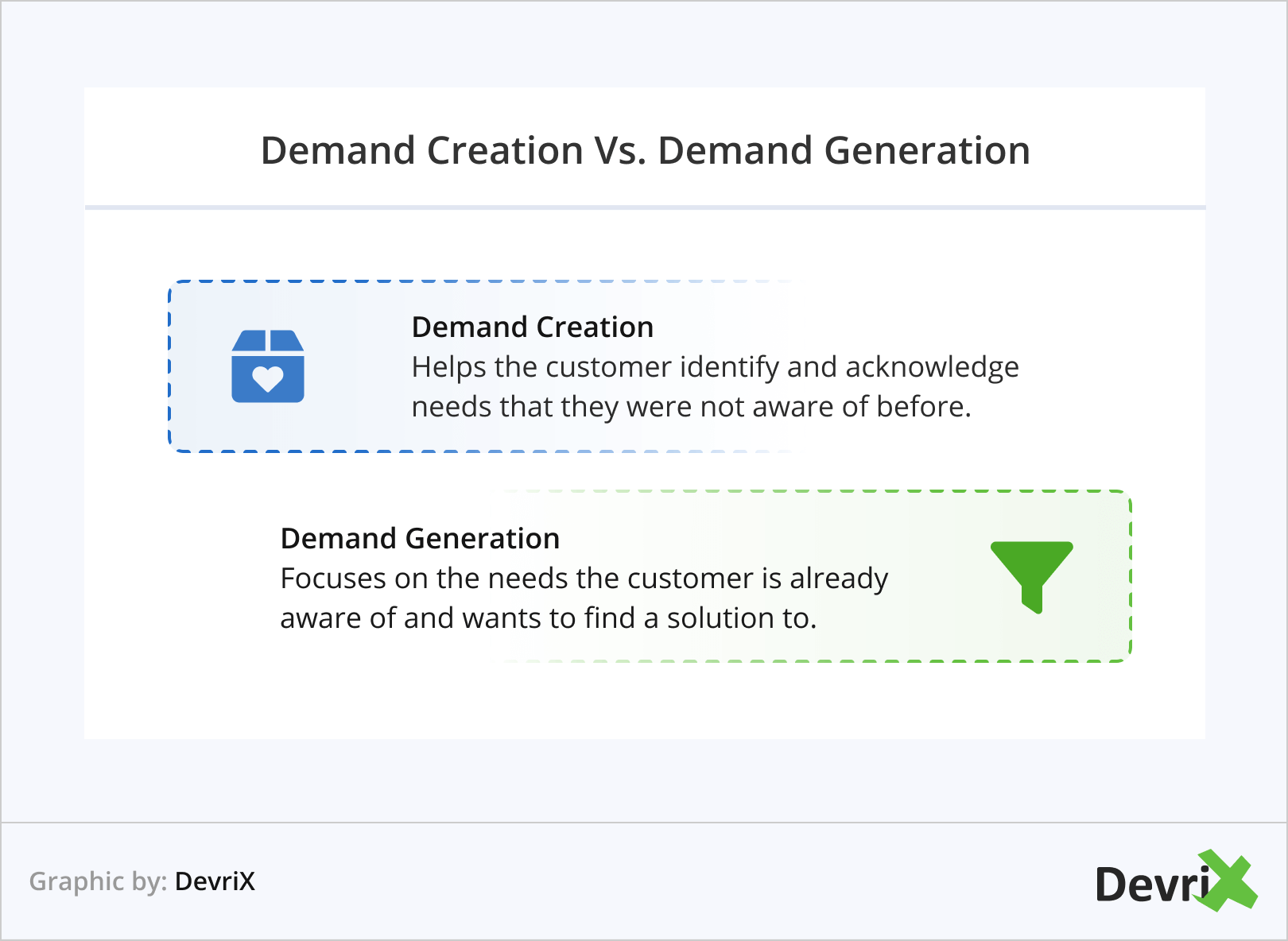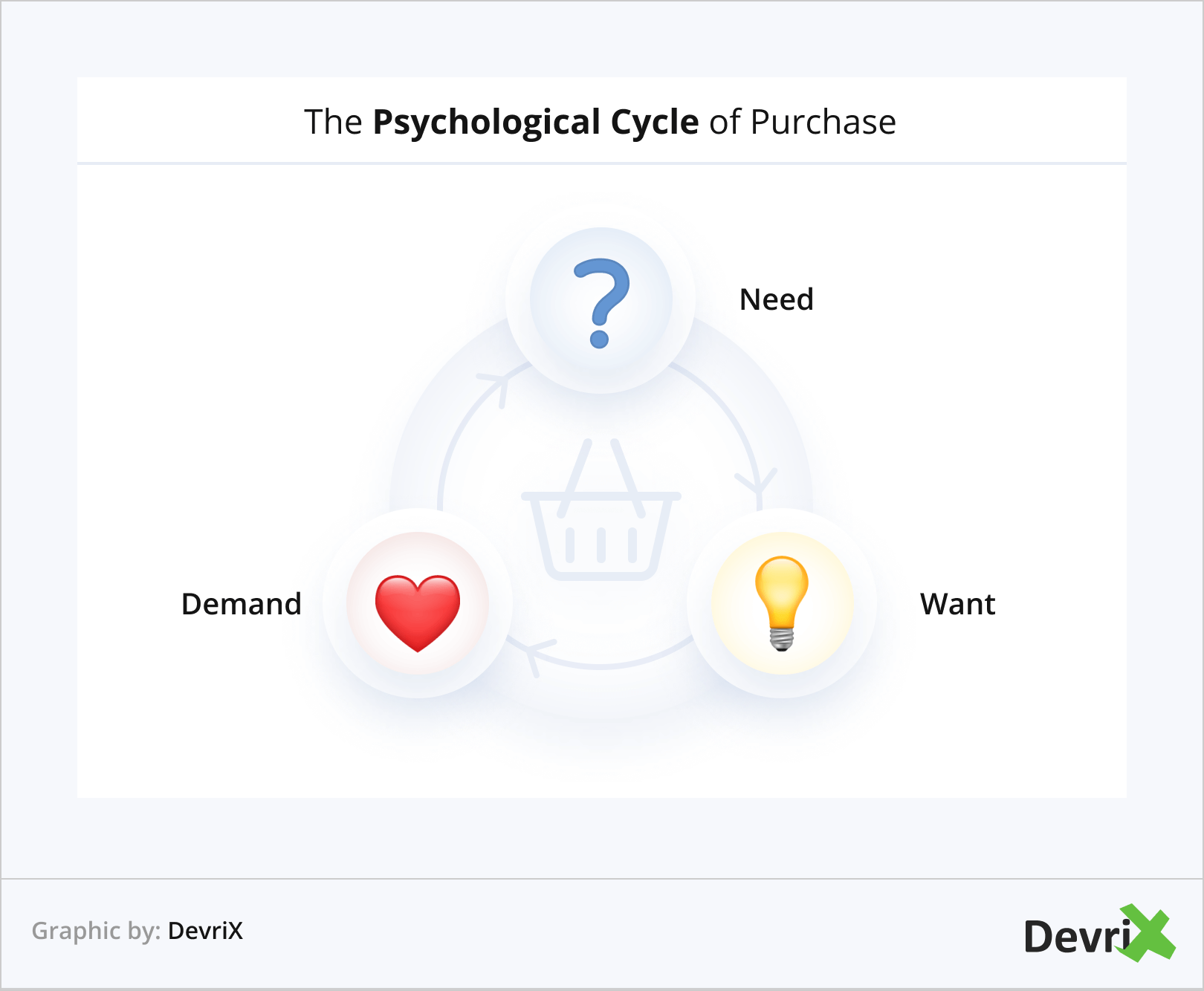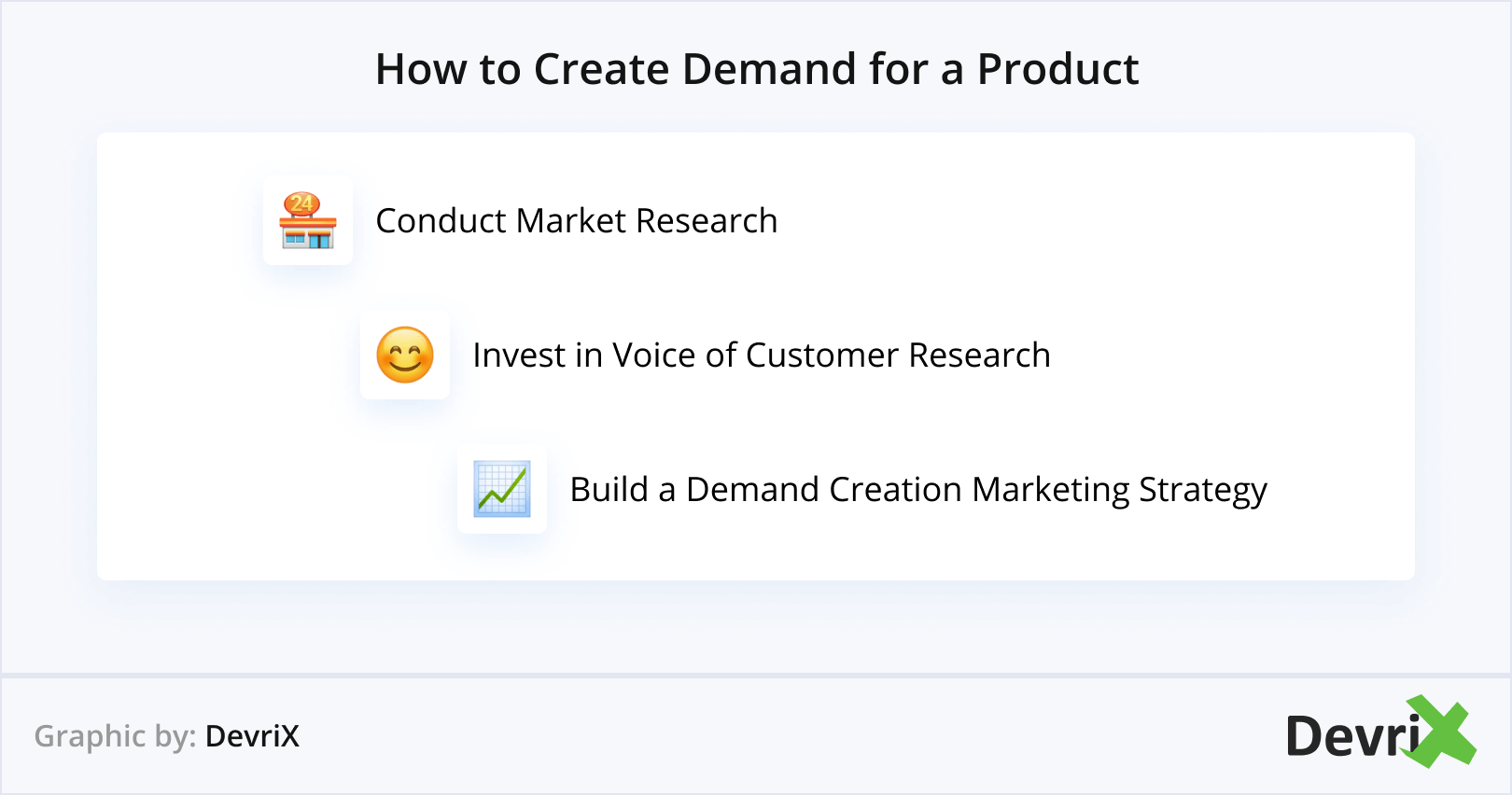New product development is exciting for companies, especially when they are launching an innovative solution that may change people’s lives for the better. However, the market is not always as eager to embrace novelty as businesses are.
To ensure the commercial success of their products, companies utilize demand creation strategies that catch the customer’s attention and draw their interest. By targeting the right audience, they create a buzz around the solution. Once this is in motion, an efficient sales and marketing strategy should do the rest. However, it all starts with creating demand.
In this article, we’ll talk about everything a business needs to know about demand creation and how to use it to benefit.
What Is Demand Creation?
Demand creation is a marketing and sales process focused on promoting new, unique, and innovative products. As those solutions are usually alien to the customer, there may initially be no demand for them in the marketplace and people may be reluctant to try them out.
Businesses analyze the product’s qualities and study the market to identify touchpoints. Based on the results, companies design campaigns to educate the customer, raise awareness, and encourage action, thus artificially creating demand. Most times customers are not even aware that they need the product or they simply do not know that an existing problem can be resolved.
In addition, demand creation can be utilized by companies when they want to penetrate a new market with an existing product or design an alternative business model for it.
However, it should be noted that the goal of demand creation is not tricking the customers into believing they need something that they actually don’t. It’s making them aware that there is something new and that it has been developed in response to a need.
Difference Between Demand Creation and Demand Generation
The terms demand creation and demand generation are often used interchangeably. However, they mean different things and service separate strategies.

Demand Creation
In order to want to buy a product, people have to recognise a need first. Then they’ll want to learn about the product and what it does, and study its advantages. However, when the product is new to market or unfamiliar to the audience, this is a bit more complex. The provided benefits are likely to be related to a need or a problem the customer doesn’t even realize exists.
For example, before the invention of mobile phones, people didn’t know that they needed a communication device that they could carry on them at all times. And before the invention of the mobile internet, we didn’t know we wanted to be constantly connected.
That’s why, when these products and services were first launched, there was initially no or little demand for them – people simply didn’t know the need existed or let alone how they could benefit from them.
However, companies managed to create an artificial demand, and now we are all hooked forever on these technologies (or at least until the next communication innovation comes our way).
Demand Generation
Demand generation, on the other hand, focuses on needs the customer already is aware of and wants to find solutions to. In this case, the company’s goal is to convince the customer that their product is better suited to their needs than the competitors.
In addition, demand generation is closely related to lead generation. The customer is already past the awareness stage of their journey and actively looking for products that they can benefit from. When they find a business that seems to fit their needs, they may become a lead.
To continue with the mobile phone example, when a company launches a new model, they focus on what improvements it offers, compared to previous versions and marketplace rivals. Customers may already have a phone that functions properly, but if the demand generation campaign hits the right spot, they may want to buy a new and better one.
The companies have already created demand and also created the need to replace your device annually, and all they have to do to generate more demand is launch a new campaign.
Why Is Demand Creation Important?
Without demand creation, companies are likely to fail to reach their audience, because, contrary to popular belief, even the best solutions don’t sell themselves.

Balances the Demand-Supply Curve
Businesses that rely on the natural processes of product discovery lose precious time and money, and their endeavor becomes less cost-effective. It is possible, of course, that people come across the product by accident and love it, but it may take ages for this to happen at scale. Furthermore, leaving things to chance is rarely a winning strategy.
To function properly, supply and demand have to be in equilibrium, otherwise, every fluctuation may break the balance. If demand rises, so should supply; if supply drops, demand jumps and supply needs to be reinstated. However, before you reach that balance, first, you have to convince people of your product’s worth.
Companies use market research and marketing strategies to study, influence, and direct demand and gain a competitive advantage. Thus, they can both manage supply and control their revenues more efficiently.
Enables the Psychological Cycle of a Purchase
Demand creation fuels the awareness stage of the customer journey and, as every marketer knows, without it there’s a high risk that the pipeline remains empty.

The psychological cycle of purchase consists of three general steps, illustrating the difference between need, want, and demand in marketing:
- Need. The customer faces obstacles – consciously or subconsciously – that they need outside assistance to overcome.
- Want. The customer becomes aware that there is a product or service that makes it possible to resolve their problems and they want to have it.
- Demand. The customer is willing to pay the required price for the product/service and is able to afford it.
In other words, if people don’t need the product, they don’t want it. If they don’t want it or can’t afford it, they don’t buy it. If they don’t buy it, there’s no demand and the product becomes obsolete.
How to Create Demand for a Product
Depending on the type of product and how novel it is, demand creation can be a difficult and time-consuming process. However, if done properly and with due diligence, it delivers promising results.
Successfully launching and promoting innovations can provide a company with an industry vanguard and opens doors to rapid development and improved brand awareness.
So how to create demand for a product?

1. Conduct Market Research
In order to find the best ways to create demand for a product, companies have to first understand their customer. Defining a target audience and creating buyer personas provides insights into what obstacles people face that the product can help them overcome.
Without a detailed profile, it’s impossible to accurately determine the spoken and unspoken needs of the customer. Companies may use different market research methods:
- Qualitative approaches like interviews, focus groups, and observational studies provide a holistic overview of the persona’s needs, what they want, how noticeable they are, and what price they are willing to pay for a product.
- Quantitative methods like surveys and closed-ended question interviews provide statistically relevant information and enable companies to test out their theories at scale. In addition, companies are able to refine the data and segment their audience based on demand levels. Leveraging this information, they can target different cohorts with a message that best resonates with their profile.
Market research may help you identify, define, and understand the customer better. However, it is not enough to provide insight into how they feel about a product that they are not yet familiar with.
2. Invest in Voice of Customer Research
Voice of the customer (VOC) is a specific type of research used in new product development and product improvement. It includes the customer and their journey into the initial stages of the R&D, and product testing, and allows them to cooperate with team members from all departments involved in developing the product. Users are encouraged to express and rate their needs, share concerns, and discuss any relevant information about the product and experience.
Companies use data from VOC to create a hierarchy or the target audience’s spoken and unspoken needs and refer to it when making pivotal product decisions. Leveraging this advantage, they can build products with the customer in mind and design them for optimal demand.
Furthermore, VOC often involves prototype testing. Businesses can witness how people respond to the product and how they use it in a natural environment, and obtain real-life feedback. This information is priceless when it comes to eliminating quality and functionality setbacks that may reduce demand in the future.
The results from voice of the customer research also provide valuable insight into how to build a marketing strategy that enables demand creation.
3. Build a Demand Creation Marketing Strategy
Demand creation marketing strategies aim to raise awareness about the product’s existence, make the audience acknowledge their needs, and educate the customers about the product’s benefits.
In other words, companies try to take control over the psychological process behind a purchase and convince the customer they need and want the product.
The top three strategies to consider are:
- Outbound. With the rise of inbound marketing in recent years, it may seem that advertising has fallen from grace. However, outbound techniques are a great way to create demand for a product. If done well, they enable you to reach a broad but targeted audience and break the ice.
Digital and traditional ads allow businesses to quickly make their products known, define branding, and boost recognition.
While the created demand is artificial and, thus, may not be long-lasting, the initial boost can be enough to get people talking and create interest in your products.
- Word-of-Mouth. Word-of-mouth (WoM) marketing campaigns involving influencer marketing, affiliate programs, initiatives that stimulate user-generated content, and so on, create a buzz around the product and make it popular. This encourages customers to want to have it, and experience the benefits.
Furthermore, when people hear about something new and interesting, they discuss it with friends and family. Peer recommendations are valuable word-of-mouth and the best means to validate the need for your products.
WoMM can make your new solution the next big thing, all the while creating incremental demand.
- Inbound. As mentioned, educating customers about products is an important part of demand creation. Once people are aware of the existence of the new solution and become intrigued, they will want to learn more details to better understand it.
Companies should invest in an inbound marketing strategy that demonstrates how the product solves the customer’s issues. They should provide walk-throughs, tutorials, webinars, videos, whitepapers, and any other relevant type of educational content.
If businesses play their cards right, they may also consolidate their brand as an industry thought-leader and become the customer’s go-to choice of innovation and relevant content.
Bottom Line
Demand creation is a complex process that requires companies to build a bridge between their new solution and their target audience. As valuable as innovation may be for making our lives easier, the market is often reluctant to embrace novelty before it’s been tried, tested, and validated by someone else.
Companies that leave their product’s commercial success to chance and hope that demand will naturally skyrocket when they launch their solution, are often disappointed and suffer financial losses. Those that invest in building a demand creation strategy, are able to connect to their audience, raise awareness about the product, and jump-start its market success.




